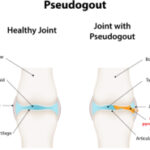Using data from the U.K.’s Health Improvement Network, a primary care database, Wei et al. examined whether urate-lowering therapy (ULT) in a treat-to-target approach for patients with gout reduces the risk of fracture.



Using data from the U.K.’s Health Improvement Network, a primary care database, Wei et al. examined whether urate-lowering therapy (ULT) in a treat-to-target approach for patients with gout reduces the risk of fracture.
In a dose-finding, clinical trial, Terkeltaub et al. examined the safety and efficacy of tigulixostat, a nonpurine xanthine oxidase inhibitor, for lowering the serum urate levels of patients with gout and hyperuricemia.

In June 2022, I listened to several presentations on gout at EULAR’s European Congress of Rheumatology. Most began with data confirming a sad truth that we, as rheumatology providers, are all aware of: too many patients are taking subtherapeutic doses of urate-lowering therapy (ULT).1,2 Recommendations from the American College of Physicians in 2017 advocated for…

Treat to Target in Gout Monitoring & achievement of target serum urate levels By Jing Li & Gabriela Schmajuk, MD, MS Why was this study done? The ACR’s 2020 guideline for the management of gout recommends using a treat-to-target (T2T) approach to lower serum urate (SU). Using the ACR’s RISE registry, we examined the use…
In this large, population-based study, Xie et al. found that the risks of SARS-CoV-2 infection, 30-day hospitalization and 30-day death were higher among individuals with gout than individuals without gout in the general population, irrespective of COVID-19 vaccination status.

PHILADELPHIA—The term pseudogout has been a source of confusion among rheumatologists, especially as our understanding of calcium pyrophosphate crystal deposition (CPPD) disease has become more nuanced. This condition has many complex and interesting facets that warrant closer investigation. An ACR Convergence 2022 session sought to update the audience on the progress to date in developing…

This ACR Convergence 2022 session focused on ways to improve health equity in Indigenous populations.
In this comparative effectiveness clinical trial, Yan et al. set out to compare nontitrated, low-dose benzbromarone (not approved in the U.S.), a renal urate transporter 1 inhibitor, with low-dose febuxostat as the first-line therapy in gout patients with renal uric acid underexcretion.

PHILADELPHIA—The term autoinflammatory syndrome was coined by Daniel L. Kastner, MD, PhD, National Institutes of Health (NIH), Bethesda, Md., not long after he discovered that mutations in the gene MEFV, which codes for the protein pyrin, are responsible for familial Mediterranean fever (FMF).1 Early on, the term was meant to signify monogenic conditions in which…

A 60-year-old Black woman with a history of stage 3 chronic kidney disease, type 2 diabetes and hypertension presented with a 12-month history of asymmetric polyarthritis of the wrists, metacarpophalangeal (MCP), proximal interphalangeal (PIP), metatarsophalangeal (MTP) and knee joints. The review of systems was unremarkable. She denied oral ulcers, rashes, alopecia, or a history of…